Research Report: Consumer Perceptions of Generic Medicines in Malaysia
VerifiedAdded on 2022/10/11
|66
|14739
|10
Report
AI Summary
This research report investigates consumer perceptions of generic and innovator medicines, focusing on the Malaysian market. The study explores the background of the healthcare industry in Malaysia, highlighting the differences between public and private sectors in medicine distribution and cost. It examines the research problem, which centers on consumers' varying perceptions of generic medicines compared to branded ones, and emphasizes the need to understand the factors influencing these perceptions. The report outlines the research objectives, questions, and hypotheses, including the influence of price and packaging. The methodology involves a survey of 100 respondents, with data analysis including descriptive statistics, frequency tables, cross-tabulation, correlation, and regression analysis. The literature review covers generic entry, brand loyalty, substitution, and the attitudes of pharmacists and physicians. The findings aim to identify key factors affecting consumer choices and recommend strategies to improve perceptions of generic medicines. The research concludes with recommendations for increasing awareness and acceptance of generic medicines in Malaysia.

Running head: MANAGEMENT
Management
Name of the student
Name of the university
Author note
Management
Name of the student
Name of the university
Author note
Paraphrase This Document
Need a fresh take? Get an instant paraphrase of this document with our AI Paraphraser
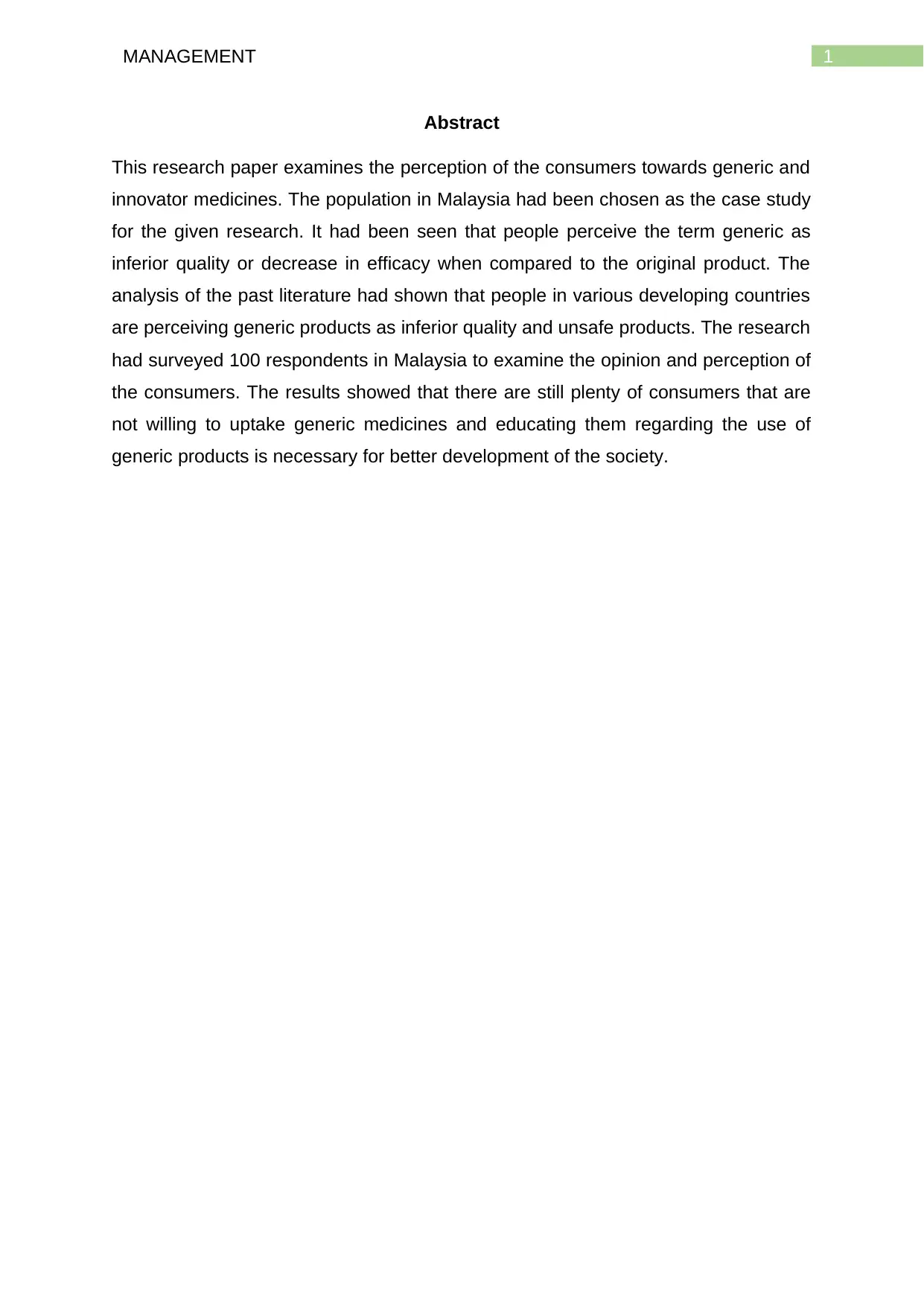
1MANAGEMENT
Abstract
This research paper examines the perception of the consumers towards generic and
innovator medicines. The population in Malaysia had been chosen as the case study
for the given research. It had been seen that people perceive the term generic as
inferior quality or decrease in efficacy when compared to the original product. The
analysis of the past literature had shown that people in various developing countries
are perceiving generic products as inferior quality and unsafe products. The research
had surveyed 100 respondents in Malaysia to examine the opinion and perception of
the consumers. The results showed that there are still plenty of consumers that are
not willing to uptake generic medicines and educating them regarding the use of
generic products is necessary for better development of the society.
Abstract
This research paper examines the perception of the consumers towards generic and
innovator medicines. The population in Malaysia had been chosen as the case study
for the given research. It had been seen that people perceive the term generic as
inferior quality or decrease in efficacy when compared to the original product. The
analysis of the past literature had shown that people in various developing countries
are perceiving generic products as inferior quality and unsafe products. The research
had surveyed 100 respondents in Malaysia to examine the opinion and perception of
the consumers. The results showed that there are still plenty of consumers that are
not willing to uptake generic medicines and educating them regarding the use of
generic products is necessary for better development of the society.
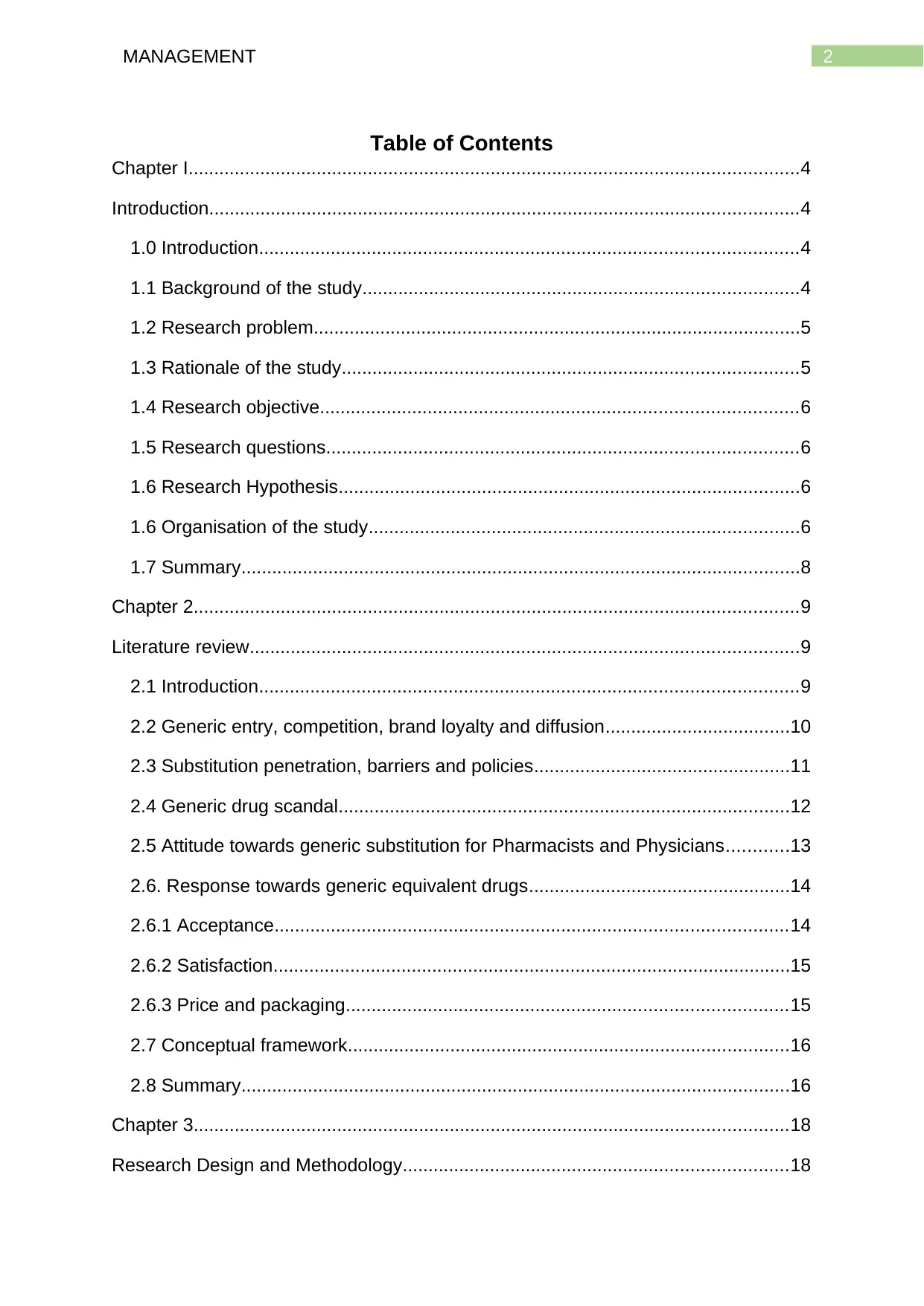
2MANAGEMENT
Table of Contents
Chapter I.......................................................................................................................4
Introduction...................................................................................................................4
1.0 Introduction.........................................................................................................4
1.1 Background of the study.....................................................................................4
1.2 Research problem...............................................................................................5
1.3 Rationale of the study.........................................................................................5
1.4 Research objective.............................................................................................6
1.5 Research questions............................................................................................6
1.6 Research Hypothesis..........................................................................................6
1.6 Organisation of the study....................................................................................6
1.7 Summary.............................................................................................................8
Chapter 2......................................................................................................................9
Literature review...........................................................................................................9
2.1 Introduction.........................................................................................................9
2.2 Generic entry, competition, brand loyalty and diffusion....................................10
2.3 Substitution penetration, barriers and policies..................................................11
2.4 Generic drug scandal........................................................................................12
2.5 Attitude towards generic substitution for Pharmacists and Physicians............13
2.6. Response towards generic equivalent drugs...................................................14
2.6.1 Acceptance....................................................................................................14
2.6.2 Satisfaction.....................................................................................................15
2.6.3 Price and packaging......................................................................................15
2.7 Conceptual framework......................................................................................16
2.8 Summary...........................................................................................................16
Chapter 3....................................................................................................................18
Research Design and Methodology...........................................................................18
Table of Contents
Chapter I.......................................................................................................................4
Introduction...................................................................................................................4
1.0 Introduction.........................................................................................................4
1.1 Background of the study.....................................................................................4
1.2 Research problem...............................................................................................5
1.3 Rationale of the study.........................................................................................5
1.4 Research objective.............................................................................................6
1.5 Research questions............................................................................................6
1.6 Research Hypothesis..........................................................................................6
1.6 Organisation of the study....................................................................................6
1.7 Summary.............................................................................................................8
Chapter 2......................................................................................................................9
Literature review...........................................................................................................9
2.1 Introduction.........................................................................................................9
2.2 Generic entry, competition, brand loyalty and diffusion....................................10
2.3 Substitution penetration, barriers and policies..................................................11
2.4 Generic drug scandal........................................................................................12
2.5 Attitude towards generic substitution for Pharmacists and Physicians............13
2.6. Response towards generic equivalent drugs...................................................14
2.6.1 Acceptance....................................................................................................14
2.6.2 Satisfaction.....................................................................................................15
2.6.3 Price and packaging......................................................................................15
2.7 Conceptual framework......................................................................................16
2.8 Summary...........................................................................................................16
Chapter 3....................................................................................................................18
Research Design and Methodology...........................................................................18
⊘ This is a preview!⊘
Do you want full access?
Subscribe today to unlock all pages.

Trusted by 1+ million students worldwide
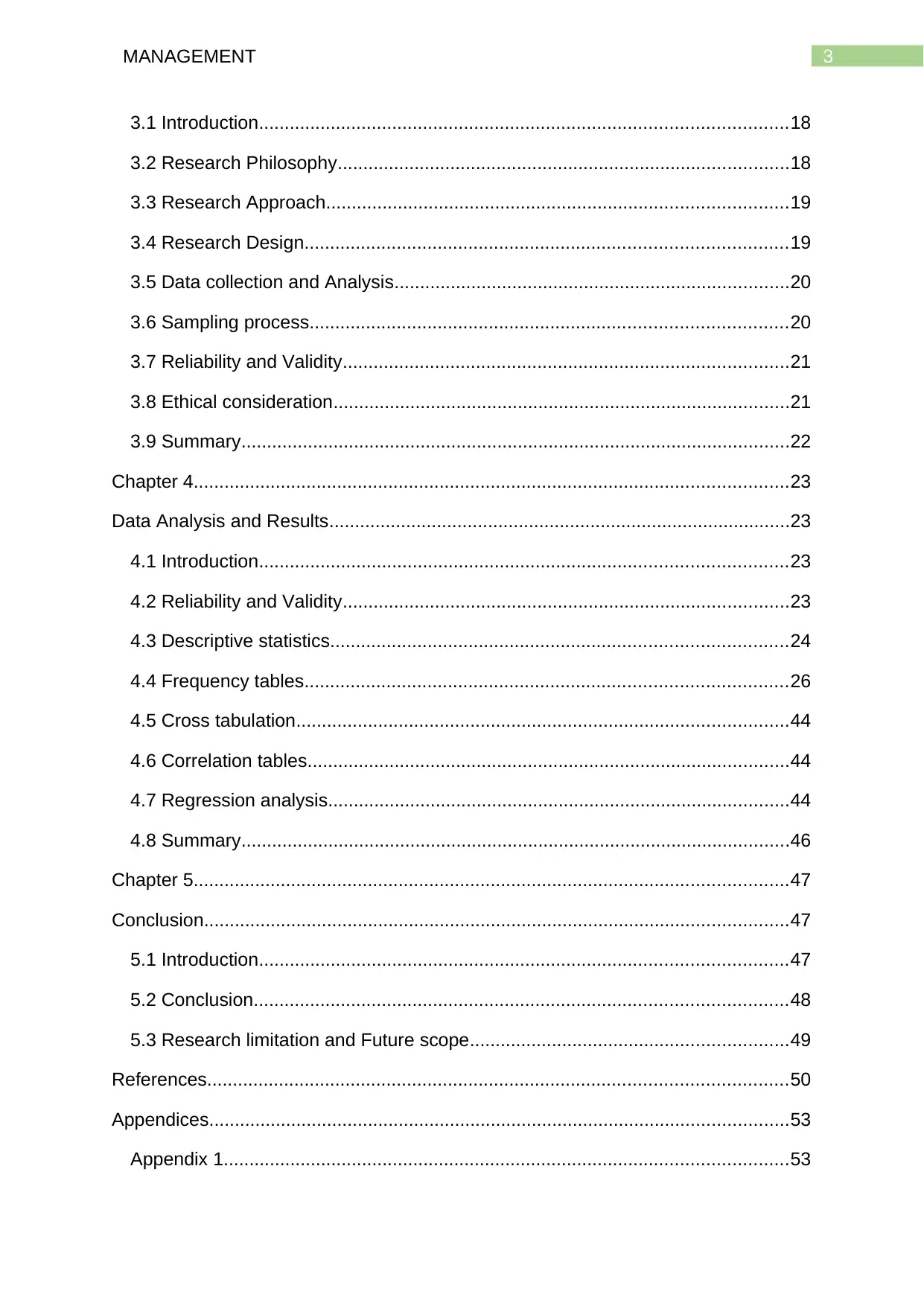
3MANAGEMENT
3.1 Introduction.......................................................................................................18
3.2 Research Philosophy........................................................................................18
3.3 Research Approach..........................................................................................19
3.4 Research Design..............................................................................................19
3.5 Data collection and Analysis.............................................................................20
3.6 Sampling process.............................................................................................20
3.7 Reliability and Validity.......................................................................................21
3.8 Ethical consideration.........................................................................................21
3.9 Summary...........................................................................................................22
Chapter 4....................................................................................................................23
Data Analysis and Results..........................................................................................23
4.1 Introduction.......................................................................................................23
4.2 Reliability and Validity.......................................................................................23
4.3 Descriptive statistics.........................................................................................24
4.4 Frequency tables..............................................................................................26
4.5 Cross tabulation................................................................................................44
4.6 Correlation tables..............................................................................................44
4.7 Regression analysis..........................................................................................44
4.8 Summary...........................................................................................................46
Chapter 5....................................................................................................................47
Conclusion..................................................................................................................47
5.1 Introduction.......................................................................................................47
5.2 Conclusion........................................................................................................48
5.3 Research limitation and Future scope..............................................................49
References.................................................................................................................50
Appendices.................................................................................................................53
Appendix 1..............................................................................................................53
3.1 Introduction.......................................................................................................18
3.2 Research Philosophy........................................................................................18
3.3 Research Approach..........................................................................................19
3.4 Research Design..............................................................................................19
3.5 Data collection and Analysis.............................................................................20
3.6 Sampling process.............................................................................................20
3.7 Reliability and Validity.......................................................................................21
3.8 Ethical consideration.........................................................................................21
3.9 Summary...........................................................................................................22
Chapter 4....................................................................................................................23
Data Analysis and Results..........................................................................................23
4.1 Introduction.......................................................................................................23
4.2 Reliability and Validity.......................................................................................23
4.3 Descriptive statistics.........................................................................................24
4.4 Frequency tables..............................................................................................26
4.5 Cross tabulation................................................................................................44
4.6 Correlation tables..............................................................................................44
4.7 Regression analysis..........................................................................................44
4.8 Summary...........................................................................................................46
Chapter 5....................................................................................................................47
Conclusion..................................................................................................................47
5.1 Introduction.......................................................................................................47
5.2 Conclusion........................................................................................................48
5.3 Research limitation and Future scope..............................................................49
References.................................................................................................................50
Appendices.................................................................................................................53
Appendix 1..............................................................................................................53
Paraphrase This Document
Need a fresh take? Get an instant paraphrase of this document with our AI Paraphraser
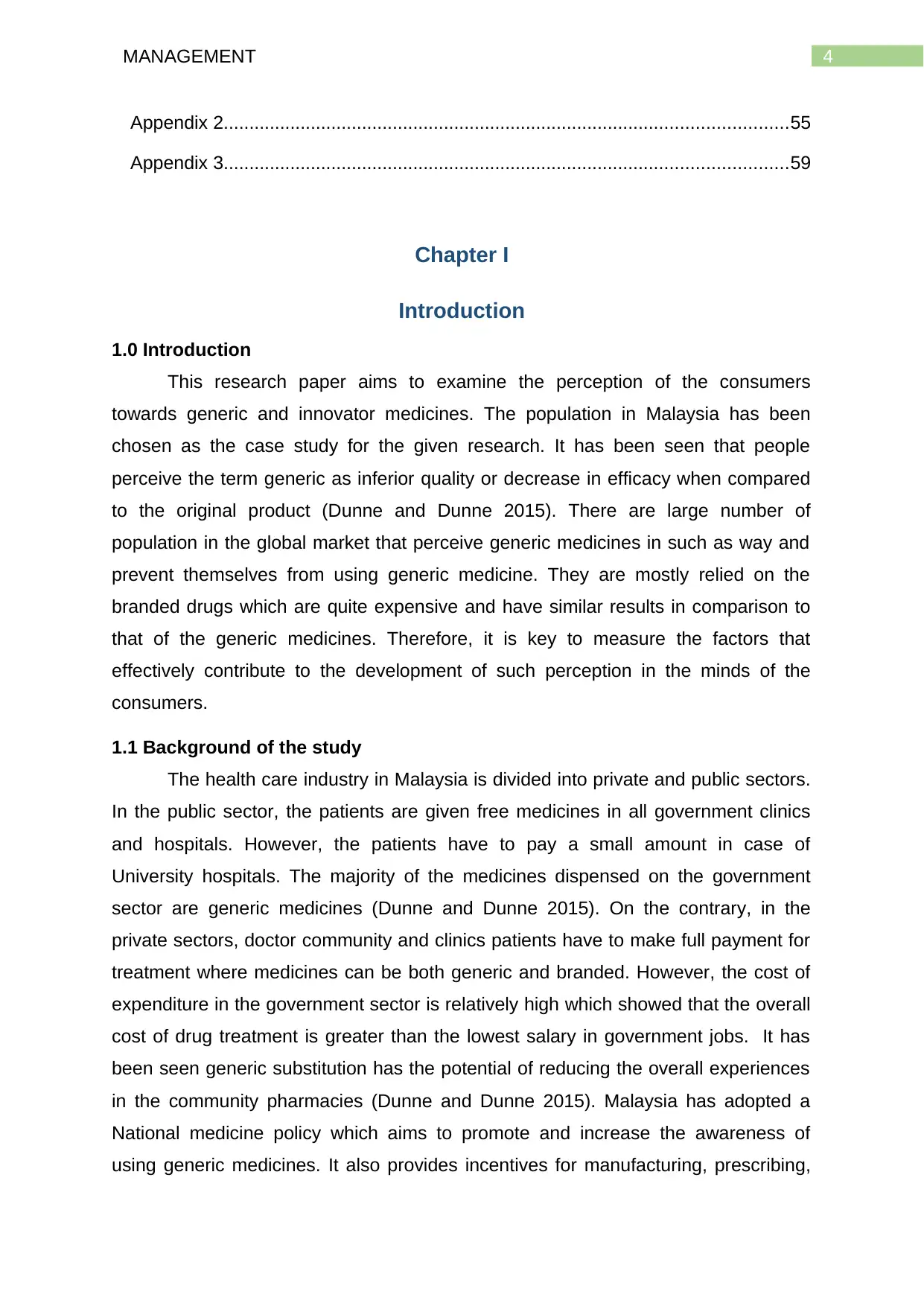
4MANAGEMENT
Appendix 2..............................................................................................................55
Appendix 3..............................................................................................................59
Chapter I
Introduction
1.0 Introduction
This research paper aims to examine the perception of the consumers
towards generic and innovator medicines. The population in Malaysia has been
chosen as the case study for the given research. It has been seen that people
perceive the term generic as inferior quality or decrease in efficacy when compared
to the original product (Dunne and Dunne 2015). There are large number of
population in the global market that perceive generic medicines in such as way and
prevent themselves from using generic medicine. They are mostly relied on the
branded drugs which are quite expensive and have similar results in comparison to
that of the generic medicines. Therefore, it is key to measure the factors that
effectively contribute to the development of such perception in the minds of the
consumers.
1.1 Background of the study
The health care industry in Malaysia is divided into private and public sectors.
In the public sector, the patients are given free medicines in all government clinics
and hospitals. However, the patients have to pay a small amount in case of
University hospitals. The majority of the medicines dispensed on the government
sector are generic medicines (Dunne and Dunne 2015). On the contrary, in the
private sectors, doctor community and clinics patients have to make full payment for
treatment where medicines can be both generic and branded. However, the cost of
expenditure in the government sector is relatively high which showed that the overall
cost of drug treatment is greater than the lowest salary in government jobs. It has
been seen generic substitution has the potential of reducing the overall experiences
in the community pharmacies (Dunne and Dunne 2015). Malaysia has adopted a
National medicine policy which aims to promote and increase the awareness of
using generic medicines. It also provides incentives for manufacturing, prescribing,
Appendix 2..............................................................................................................55
Appendix 3..............................................................................................................59
Chapter I
Introduction
1.0 Introduction
This research paper aims to examine the perception of the consumers
towards generic and innovator medicines. The population in Malaysia has been
chosen as the case study for the given research. It has been seen that people
perceive the term generic as inferior quality or decrease in efficacy when compared
to the original product (Dunne and Dunne 2015). There are large number of
population in the global market that perceive generic medicines in such as way and
prevent themselves from using generic medicine. They are mostly relied on the
branded drugs which are quite expensive and have similar results in comparison to
that of the generic medicines. Therefore, it is key to measure the factors that
effectively contribute to the development of such perception in the minds of the
consumers.
1.1 Background of the study
The health care industry in Malaysia is divided into private and public sectors.
In the public sector, the patients are given free medicines in all government clinics
and hospitals. However, the patients have to pay a small amount in case of
University hospitals. The majority of the medicines dispensed on the government
sector are generic medicines (Dunne and Dunne 2015). On the contrary, in the
private sectors, doctor community and clinics patients have to make full payment for
treatment where medicines can be both generic and branded. However, the cost of
expenditure in the government sector is relatively high which showed that the overall
cost of drug treatment is greater than the lowest salary in government jobs. It has
been seen generic substitution has the potential of reducing the overall experiences
in the community pharmacies (Dunne and Dunne 2015). Malaysia has adopted a
National medicine policy which aims to promote and increase the awareness of
using generic medicines. It also provides incentives for manufacturing, prescribing,
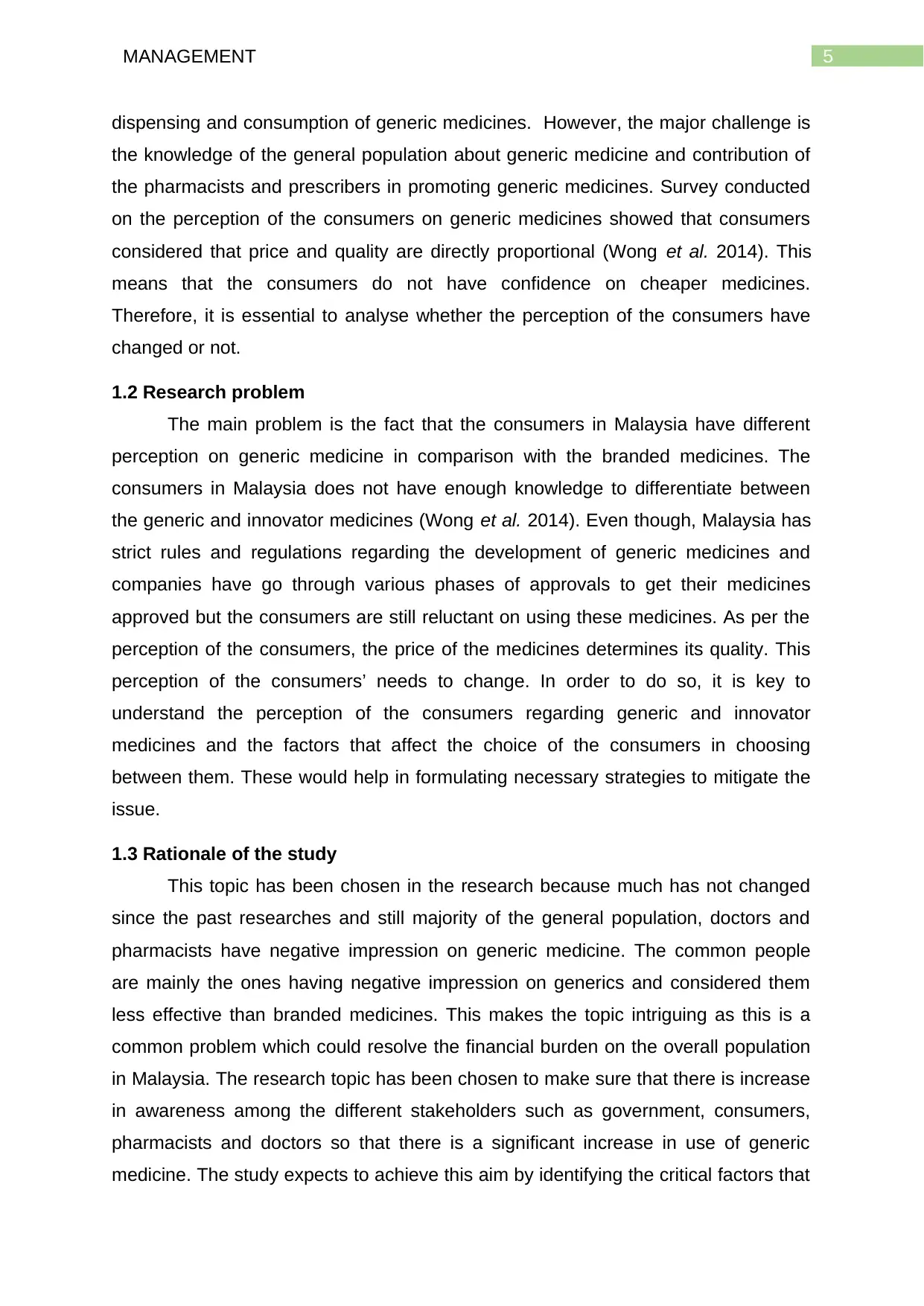
5MANAGEMENT
dispensing and consumption of generic medicines. However, the major challenge is
the knowledge of the general population about generic medicine and contribution of
the pharmacists and prescribers in promoting generic medicines. Survey conducted
on the perception of the consumers on generic medicines showed that consumers
considered that price and quality are directly proportional (Wong et al. 2014). This
means that the consumers do not have confidence on cheaper medicines.
Therefore, it is essential to analyse whether the perception of the consumers have
changed or not.
1.2 Research problem
The main problem is the fact that the consumers in Malaysia have different
perception on generic medicine in comparison with the branded medicines. The
consumers in Malaysia does not have enough knowledge to differentiate between
the generic and innovator medicines (Wong et al. 2014). Even though, Malaysia has
strict rules and regulations regarding the development of generic medicines and
companies have go through various phases of approvals to get their medicines
approved but the consumers are still reluctant on using these medicines. As per the
perception of the consumers, the price of the medicines determines its quality. This
perception of the consumers’ needs to change. In order to do so, it is key to
understand the perception of the consumers regarding generic and innovator
medicines and the factors that affect the choice of the consumers in choosing
between them. These would help in formulating necessary strategies to mitigate the
issue.
1.3 Rationale of the study
This topic has been chosen in the research because much has not changed
since the past researches and still majority of the general population, doctors and
pharmacists have negative impression on generic medicine. The common people
are mainly the ones having negative impression on generics and considered them
less effective than branded medicines. This makes the topic intriguing as this is a
common problem which could resolve the financial burden on the overall population
in Malaysia. The research topic has been chosen to make sure that there is increase
in awareness among the different stakeholders such as government, consumers,
pharmacists and doctors so that there is a significant increase in use of generic
medicine. The study expects to achieve this aim by identifying the critical factors that
dispensing and consumption of generic medicines. However, the major challenge is
the knowledge of the general population about generic medicine and contribution of
the pharmacists and prescribers in promoting generic medicines. Survey conducted
on the perception of the consumers on generic medicines showed that consumers
considered that price and quality are directly proportional (Wong et al. 2014). This
means that the consumers do not have confidence on cheaper medicines.
Therefore, it is essential to analyse whether the perception of the consumers have
changed or not.
1.2 Research problem
The main problem is the fact that the consumers in Malaysia have different
perception on generic medicine in comparison with the branded medicines. The
consumers in Malaysia does not have enough knowledge to differentiate between
the generic and innovator medicines (Wong et al. 2014). Even though, Malaysia has
strict rules and regulations regarding the development of generic medicines and
companies have go through various phases of approvals to get their medicines
approved but the consumers are still reluctant on using these medicines. As per the
perception of the consumers, the price of the medicines determines its quality. This
perception of the consumers’ needs to change. In order to do so, it is key to
understand the perception of the consumers regarding generic and innovator
medicines and the factors that affect the choice of the consumers in choosing
between them. These would help in formulating necessary strategies to mitigate the
issue.
1.3 Rationale of the study
This topic has been chosen in the research because much has not changed
since the past researches and still majority of the general population, doctors and
pharmacists have negative impression on generic medicine. The common people
are mainly the ones having negative impression on generics and considered them
less effective than branded medicines. This makes the topic intriguing as this is a
common problem which could resolve the financial burden on the overall population
in Malaysia. The research topic has been chosen to make sure that there is increase
in awareness among the different stakeholders such as government, consumers,
pharmacists and doctors so that there is a significant increase in use of generic
medicine. The study expects to achieve this aim by identifying the critical factors that
⊘ This is a preview!⊘
Do you want full access?
Subscribe today to unlock all pages.

Trusted by 1+ million students worldwide
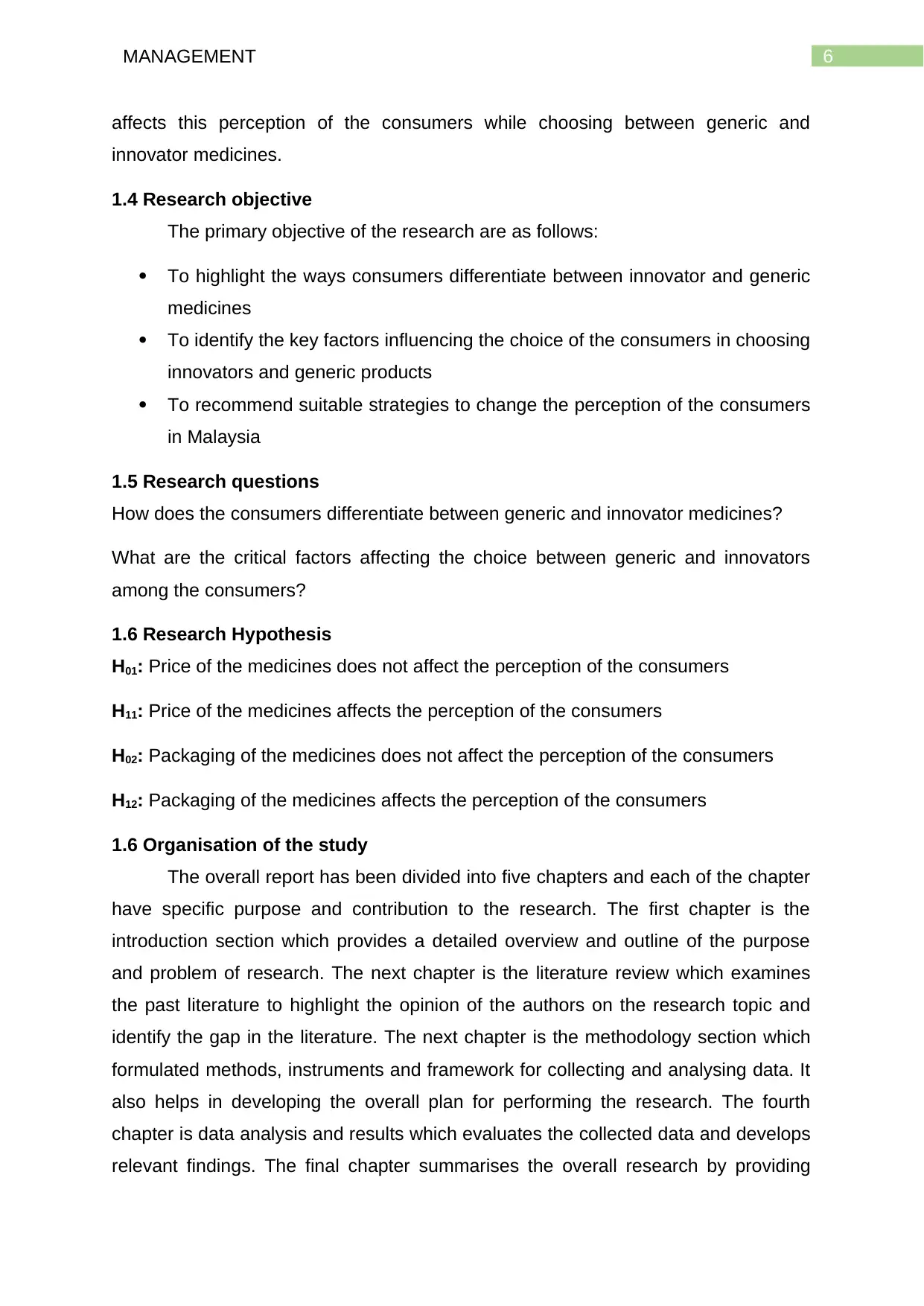
6MANAGEMENT
affects this perception of the consumers while choosing between generic and
innovator medicines.
1.4 Research objective
The primary objective of the research are as follows:
To highlight the ways consumers differentiate between innovator and generic
medicines
To identify the key factors influencing the choice of the consumers in choosing
innovators and generic products
To recommend suitable strategies to change the perception of the consumers
in Malaysia
1.5 Research questions
How does the consumers differentiate between generic and innovator medicines?
What are the critical factors affecting the choice between generic and innovators
among the consumers?
1.6 Research Hypothesis
H01: Price of the medicines does not affect the perception of the consumers
H11: Price of the medicines affects the perception of the consumers
H02: Packaging of the medicines does not affect the perception of the consumers
H12: Packaging of the medicines affects the perception of the consumers
1.6 Organisation of the study
The overall report has been divided into five chapters and each of the chapter
have specific purpose and contribution to the research. The first chapter is the
introduction section which provides a detailed overview and outline of the purpose
and problem of research. The next chapter is the literature review which examines
the past literature to highlight the opinion of the authors on the research topic and
identify the gap in the literature. The next chapter is the methodology section which
formulated methods, instruments and framework for collecting and analysing data. It
also helps in developing the overall plan for performing the research. The fourth
chapter is data analysis and results which evaluates the collected data and develops
relevant findings. The final chapter summarises the overall research by providing
affects this perception of the consumers while choosing between generic and
innovator medicines.
1.4 Research objective
The primary objective of the research are as follows:
To highlight the ways consumers differentiate between innovator and generic
medicines
To identify the key factors influencing the choice of the consumers in choosing
innovators and generic products
To recommend suitable strategies to change the perception of the consumers
in Malaysia
1.5 Research questions
How does the consumers differentiate between generic and innovator medicines?
What are the critical factors affecting the choice between generic and innovators
among the consumers?
1.6 Research Hypothesis
H01: Price of the medicines does not affect the perception of the consumers
H11: Price of the medicines affects the perception of the consumers
H02: Packaging of the medicines does not affect the perception of the consumers
H12: Packaging of the medicines affects the perception of the consumers
1.6 Organisation of the study
The overall report has been divided into five chapters and each of the chapter
have specific purpose and contribution to the research. The first chapter is the
introduction section which provides a detailed overview and outline of the purpose
and problem of research. The next chapter is the literature review which examines
the past literature to highlight the opinion of the authors on the research topic and
identify the gap in the literature. The next chapter is the methodology section which
formulated methods, instruments and framework for collecting and analysing data. It
also helps in developing the overall plan for performing the research. The fourth
chapter is data analysis and results which evaluates the collected data and develops
relevant findings. The final chapter summarises the overall research by providing
Paraphrase This Document
Need a fresh take? Get an instant paraphrase of this document with our AI Paraphraser
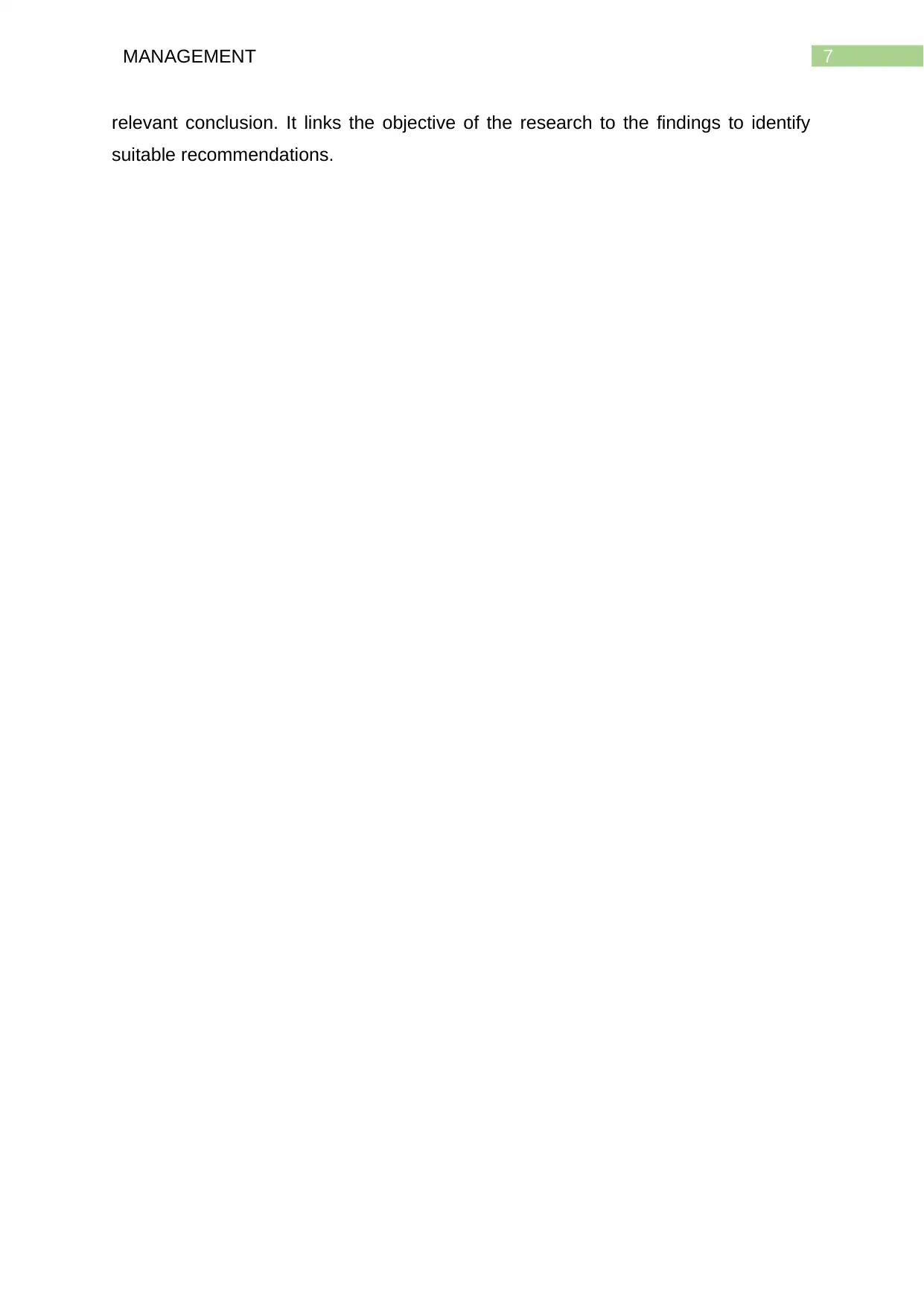
7MANAGEMENT
relevant conclusion. It links the objective of the research to the findings to identify
suitable recommendations.
relevant conclusion. It links the objective of the research to the findings to identify
suitable recommendations.
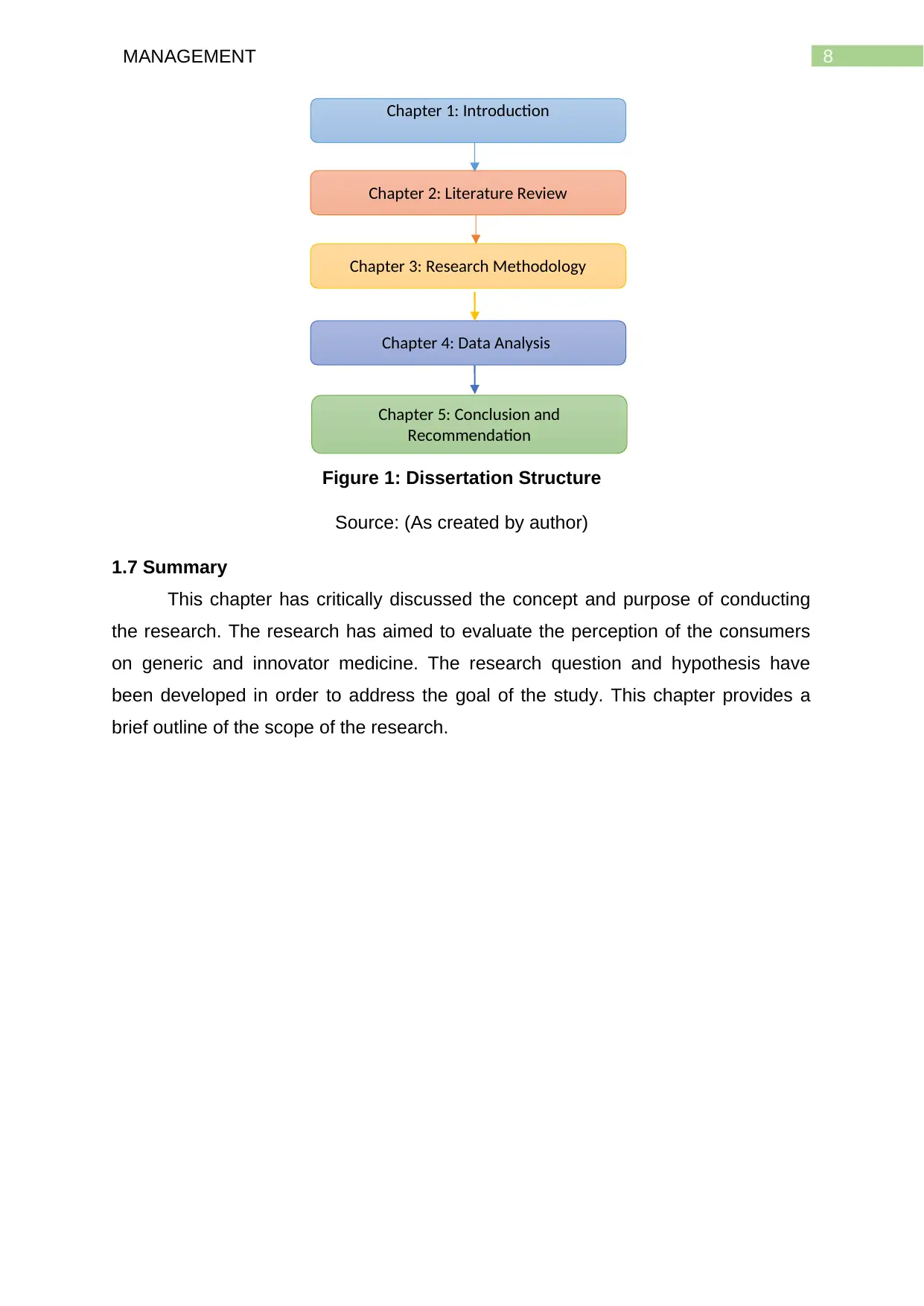
8MANAGEMENT
Figure 1: Dissertation Structure
Source: (As created by author)
1.7 Summary
This chapter has critically discussed the concept and purpose of conducting
the research. The research has aimed to evaluate the perception of the consumers
on generic and innovator medicine. The research question and hypothesis have
been developed in order to address the goal of the study. This chapter provides a
brief outline of the scope of the research.
Chapter 5: Conclusion and
Recommendation
Chapter 4: Data Analysis
Chapter 1: Introduction
Chapter 2: Literature Review
Chapter 3: Research Methodology
Figure 1: Dissertation Structure
Source: (As created by author)
1.7 Summary
This chapter has critically discussed the concept and purpose of conducting
the research. The research has aimed to evaluate the perception of the consumers
on generic and innovator medicine. The research question and hypothesis have
been developed in order to address the goal of the study. This chapter provides a
brief outline of the scope of the research.
Chapter 5: Conclusion and
Recommendation
Chapter 4: Data Analysis
Chapter 1: Introduction
Chapter 2: Literature Review
Chapter 3: Research Methodology
⊘ This is a preview!⊘
Do you want full access?
Subscribe today to unlock all pages.

Trusted by 1+ million students worldwide
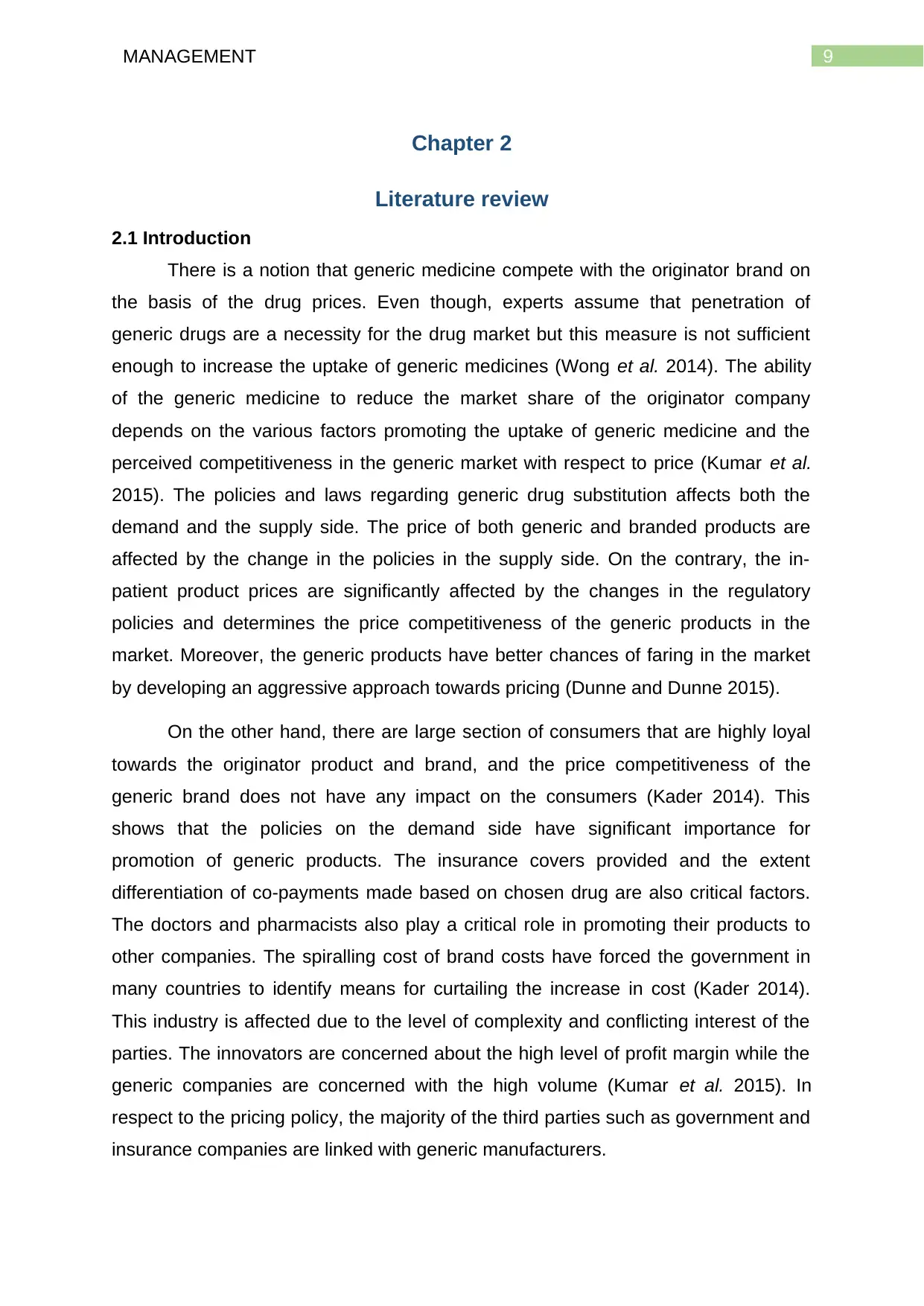
9MANAGEMENT
Chapter 2
Literature review
2.1 Introduction
There is a notion that generic medicine compete with the originator brand on
the basis of the drug prices. Even though, experts assume that penetration of
generic drugs are a necessity for the drug market but this measure is not sufficient
enough to increase the uptake of generic medicines (Wong et al. 2014). The ability
of the generic medicine to reduce the market share of the originator company
depends on the various factors promoting the uptake of generic medicine and the
perceived competitiveness in the generic market with respect to price (Kumar et al.
2015). The policies and laws regarding generic drug substitution affects both the
demand and the supply side. The price of both generic and branded products are
affected by the change in the policies in the supply side. On the contrary, the in-
patient product prices are significantly affected by the changes in the regulatory
policies and determines the price competitiveness of the generic products in the
market. Moreover, the generic products have better chances of faring in the market
by developing an aggressive approach towards pricing (Dunne and Dunne 2015).
On the other hand, there are large section of consumers that are highly loyal
towards the originator product and brand, and the price competitiveness of the
generic brand does not have any impact on the consumers (Kader 2014). This
shows that the policies on the demand side have significant importance for
promotion of generic products. The insurance covers provided and the extent
differentiation of co-payments made based on chosen drug are also critical factors.
The doctors and pharmacists also play a critical role in promoting their products to
other companies. The spiralling cost of brand costs have forced the government in
many countries to identify means for curtailing the increase in cost (Kader 2014).
This industry is affected due to the level of complexity and conflicting interest of the
parties. The innovators are concerned about the high level of profit margin while the
generic companies are concerned with the high volume (Kumar et al. 2015). In
respect to the pricing policy, the majority of the third parties such as government and
insurance companies are linked with generic manufacturers.
Chapter 2
Literature review
2.1 Introduction
There is a notion that generic medicine compete with the originator brand on
the basis of the drug prices. Even though, experts assume that penetration of
generic drugs are a necessity for the drug market but this measure is not sufficient
enough to increase the uptake of generic medicines (Wong et al. 2014). The ability
of the generic medicine to reduce the market share of the originator company
depends on the various factors promoting the uptake of generic medicine and the
perceived competitiveness in the generic market with respect to price (Kumar et al.
2015). The policies and laws regarding generic drug substitution affects both the
demand and the supply side. The price of both generic and branded products are
affected by the change in the policies in the supply side. On the contrary, the in-
patient product prices are significantly affected by the changes in the regulatory
policies and determines the price competitiveness of the generic products in the
market. Moreover, the generic products have better chances of faring in the market
by developing an aggressive approach towards pricing (Dunne and Dunne 2015).
On the other hand, there are large section of consumers that are highly loyal
towards the originator product and brand, and the price competitiveness of the
generic brand does not have any impact on the consumers (Kader 2014). This
shows that the policies on the demand side have significant importance for
promotion of generic products. The insurance covers provided and the extent
differentiation of co-payments made based on chosen drug are also critical factors.
The doctors and pharmacists also play a critical role in promoting their products to
other companies. The spiralling cost of brand costs have forced the government in
many countries to identify means for curtailing the increase in cost (Kader 2014).
This industry is affected due to the level of complexity and conflicting interest of the
parties. The innovators are concerned about the high level of profit margin while the
generic companies are concerned with the high volume (Kumar et al. 2015). In
respect to the pricing policy, the majority of the third parties such as government and
insurance companies are linked with generic manufacturers.
Paraphrase This Document
Need a fresh take? Get an instant paraphrase of this document with our AI Paraphraser
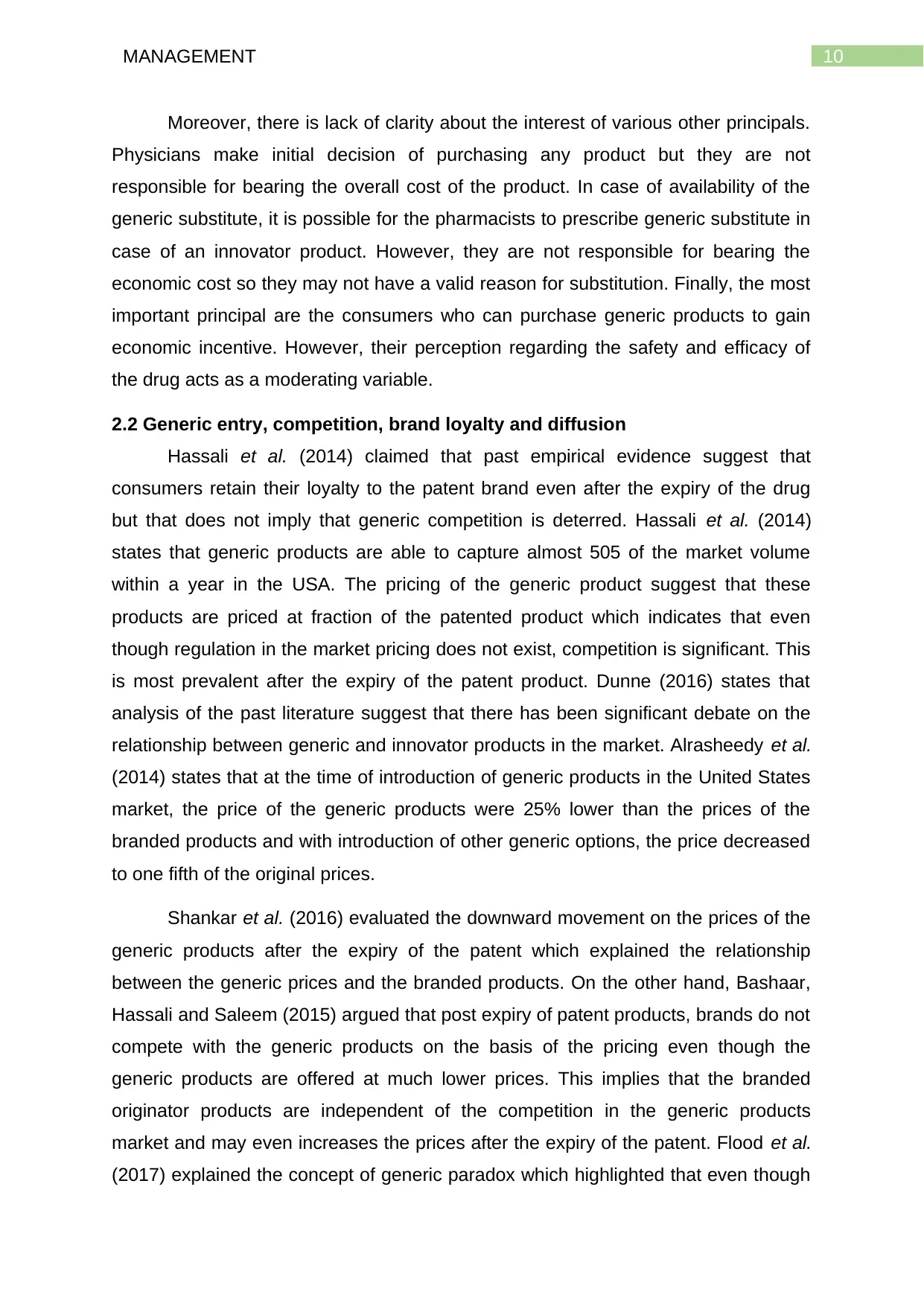
10MANAGEMENT
Moreover, there is lack of clarity about the interest of various other principals.
Physicians make initial decision of purchasing any product but they are not
responsible for bearing the overall cost of the product. In case of availability of the
generic substitute, it is possible for the pharmacists to prescribe generic substitute in
case of an innovator product. However, they are not responsible for bearing the
economic cost so they may not have a valid reason for substitution. Finally, the most
important principal are the consumers who can purchase generic products to gain
economic incentive. However, their perception regarding the safety and efficacy of
the drug acts as a moderating variable.
2.2 Generic entry, competition, brand loyalty and diffusion
Hassali et al. (2014) claimed that past empirical evidence suggest that
consumers retain their loyalty to the patent brand even after the expiry of the drug
but that does not imply that generic competition is deterred. Hassali et al. (2014)
states that generic products are able to capture almost 505 of the market volume
within a year in the USA. The pricing of the generic product suggest that these
products are priced at fraction of the patented product which indicates that even
though regulation in the market pricing does not exist, competition is significant. This
is most prevalent after the expiry of the patent product. Dunne (2016) states that
analysis of the past literature suggest that there has been significant debate on the
relationship between generic and innovator products in the market. Alrasheedy et al.
(2014) states that at the time of introduction of generic products in the United States
market, the price of the generic products were 25% lower than the prices of the
branded products and with introduction of other generic options, the price decreased
to one fifth of the original prices.
Shankar et al. (2016) evaluated the downward movement on the prices of the
generic products after the expiry of the patent which explained the relationship
between the generic prices and the branded products. On the other hand, Bashaar,
Hassali and Saleem (2015) argued that post expiry of patent products, brands do not
compete with the generic products on the basis of the pricing even though the
generic products are offered at much lower prices. This implies that the branded
originator products are independent of the competition in the generic products
market and may even increases the prices after the expiry of the patent. Flood et al.
(2017) explained the concept of generic paradox which highlighted that even though
Moreover, there is lack of clarity about the interest of various other principals.
Physicians make initial decision of purchasing any product but they are not
responsible for bearing the overall cost of the product. In case of availability of the
generic substitute, it is possible for the pharmacists to prescribe generic substitute in
case of an innovator product. However, they are not responsible for bearing the
economic cost so they may not have a valid reason for substitution. Finally, the most
important principal are the consumers who can purchase generic products to gain
economic incentive. However, their perception regarding the safety and efficacy of
the drug acts as a moderating variable.
2.2 Generic entry, competition, brand loyalty and diffusion
Hassali et al. (2014) claimed that past empirical evidence suggest that
consumers retain their loyalty to the patent brand even after the expiry of the drug
but that does not imply that generic competition is deterred. Hassali et al. (2014)
states that generic products are able to capture almost 505 of the market volume
within a year in the USA. The pricing of the generic product suggest that these
products are priced at fraction of the patented product which indicates that even
though regulation in the market pricing does not exist, competition is significant. This
is most prevalent after the expiry of the patent product. Dunne (2016) states that
analysis of the past literature suggest that there has been significant debate on the
relationship between generic and innovator products in the market. Alrasheedy et al.
(2014) states that at the time of introduction of generic products in the United States
market, the price of the generic products were 25% lower than the prices of the
branded products and with introduction of other generic options, the price decreased
to one fifth of the original prices.
Shankar et al. (2016) evaluated the downward movement on the prices of the
generic products after the expiry of the patent which explained the relationship
between the generic prices and the branded products. On the other hand, Bashaar,
Hassali and Saleem (2015) argued that post expiry of patent products, brands do not
compete with the generic products on the basis of the pricing even though the
generic products are offered at much lower prices. This implies that the branded
originator products are independent of the competition in the generic products
market and may even increases the prices after the expiry of the patent. Flood et al.
(2017) explained the concept of generic paradox which highlighted that even though
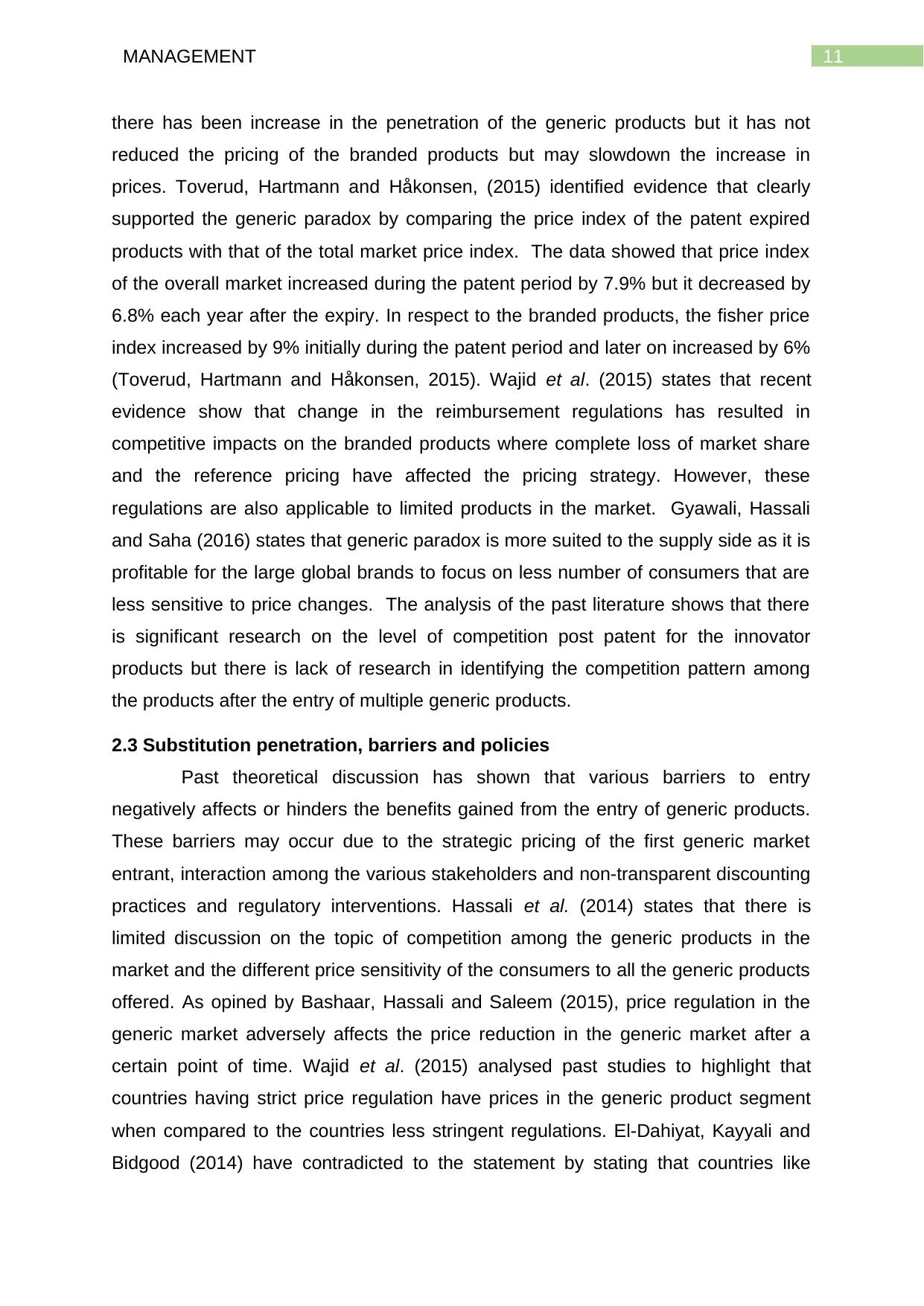
11MANAGEMENT
there has been increase in the penetration of the generic products but it has not
reduced the pricing of the branded products but may slowdown the increase in
prices. Toverud, Hartmann and Håkonsen, (2015) identified evidence that clearly
supported the generic paradox by comparing the price index of the patent expired
products with that of the total market price index. The data showed that price index
of the overall market increased during the patent period by 7.9% but it decreased by
6.8% each year after the expiry. In respect to the branded products, the fisher price
index increased by 9% initially during the patent period and later on increased by 6%
(Toverud, Hartmann and Håkonsen, 2015). Wajid et al. (2015) states that recent
evidence show that change in the reimbursement regulations has resulted in
competitive impacts on the branded products where complete loss of market share
and the reference pricing have affected the pricing strategy. However, these
regulations are also applicable to limited products in the market. Gyawali, Hassali
and Saha (2016) states that generic paradox is more suited to the supply side as it is
profitable for the large global brands to focus on less number of consumers that are
less sensitive to price changes. The analysis of the past literature shows that there
is significant research on the level of competition post patent for the innovator
products but there is lack of research in identifying the competition pattern among
the products after the entry of multiple generic products.
2.3 Substitution penetration, barriers and policies
Past theoretical discussion has shown that various barriers to entry
negatively affects or hinders the benefits gained from the entry of generic products.
These barriers may occur due to the strategic pricing of the first generic market
entrant, interaction among the various stakeholders and non-transparent discounting
practices and regulatory interventions. Hassali et al. (2014) states that there is
limited discussion on the topic of competition among the generic products in the
market and the different price sensitivity of the consumers to all the generic products
offered. As opined by Bashaar, Hassali and Saleem (2015), price regulation in the
generic market adversely affects the price reduction in the generic market after a
certain point of time. Wajid et al. (2015) analysed past studies to highlight that
countries having strict price regulation have prices in the generic product segment
when compared to the countries less stringent regulations. El-Dahiyat, Kayyali and
Bidgood (2014) have contradicted to the statement by stating that countries like
there has been increase in the penetration of the generic products but it has not
reduced the pricing of the branded products but may slowdown the increase in
prices. Toverud, Hartmann and Håkonsen, (2015) identified evidence that clearly
supported the generic paradox by comparing the price index of the patent expired
products with that of the total market price index. The data showed that price index
of the overall market increased during the patent period by 7.9% but it decreased by
6.8% each year after the expiry. In respect to the branded products, the fisher price
index increased by 9% initially during the patent period and later on increased by 6%
(Toverud, Hartmann and Håkonsen, 2015). Wajid et al. (2015) states that recent
evidence show that change in the reimbursement regulations has resulted in
competitive impacts on the branded products where complete loss of market share
and the reference pricing have affected the pricing strategy. However, these
regulations are also applicable to limited products in the market. Gyawali, Hassali
and Saha (2016) states that generic paradox is more suited to the supply side as it is
profitable for the large global brands to focus on less number of consumers that are
less sensitive to price changes. The analysis of the past literature shows that there
is significant research on the level of competition post patent for the innovator
products but there is lack of research in identifying the competition pattern among
the products after the entry of multiple generic products.
2.3 Substitution penetration, barriers and policies
Past theoretical discussion has shown that various barriers to entry
negatively affects or hinders the benefits gained from the entry of generic products.
These barriers may occur due to the strategic pricing of the first generic market
entrant, interaction among the various stakeholders and non-transparent discounting
practices and regulatory interventions. Hassali et al. (2014) states that there is
limited discussion on the topic of competition among the generic products in the
market and the different price sensitivity of the consumers to all the generic products
offered. As opined by Bashaar, Hassali and Saleem (2015), price regulation in the
generic market adversely affects the price reduction in the generic market after a
certain point of time. Wajid et al. (2015) analysed past studies to highlight that
countries having strict price regulation have prices in the generic product segment
when compared to the countries less stringent regulations. El-Dahiyat, Kayyali and
Bidgood (2014) have contradicted to the statement by stating that countries like
⊘ This is a preview!⊘
Do you want full access?
Subscribe today to unlock all pages.

Trusted by 1+ million students worldwide
1 out of 66
Related Documents
Your All-in-One AI-Powered Toolkit for Academic Success.
+13062052269
info@desklib.com
Available 24*7 on WhatsApp / Email
![[object Object]](/_next/static/media/star-bottom.7253800d.svg)
Unlock your academic potential
Copyright © 2020–2025 A2Z Services. All Rights Reserved. Developed and managed by ZUCOL.





